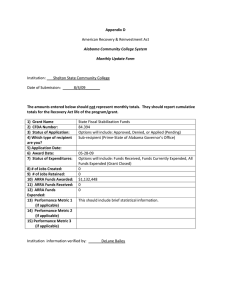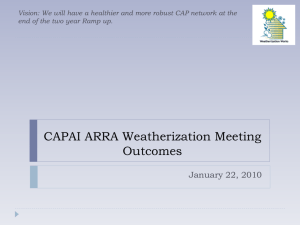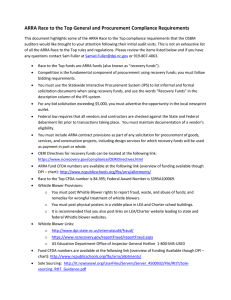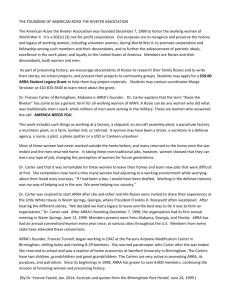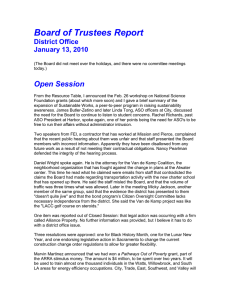arrA Is a Reliable Marker for As(V) Respiration
advertisement
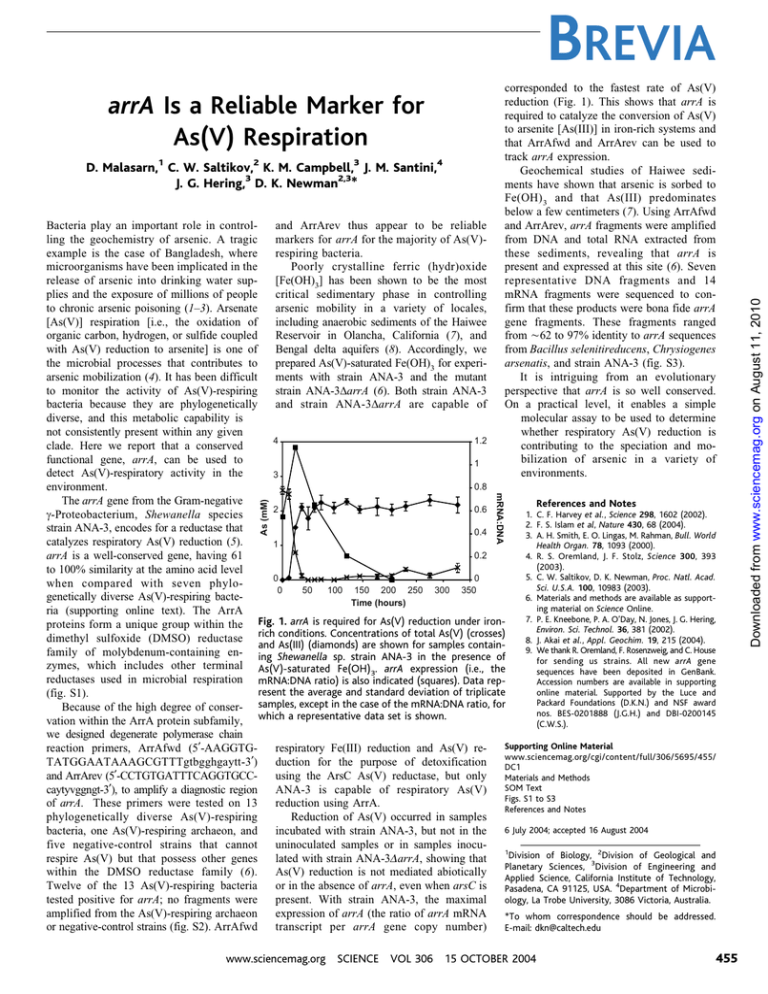
corresponded to the fastest rate of As(V) reduction (Fig. 1). This shows that arrA is required to catalyze the conversion of As(V) to arsenite EAs(III)^ in iron-rich systems and that ArrAfwd and ArrArev can be used to track arrA expression. Geochemical studies of Haiwee sediments have shown that arsenic is sorbed to Fe(OH) 3 and that As(III) predominates below a few centimeters (7). Using ArrAfwd and ArrArev, arrA fragments were amplified from DNA and total RNA extracted from these sediments, revealing that arrA is present and expressed at this site (6). Seven representative DNA fragments and 14 mRNA fragments were sequenced to confirm that these products were bona fide arrA gene fragments. These fragments ranged from È62 to 97% identity to arrA sequences from Bacillus selenitireducens, Chrysiogenes arsenatis, and strain ANA-3 (fig. S3). It is intriguing from an evolutionary perspective that arrA is so well conserved. On a practical level, it enables a simple molecular assay to be used to determine whether respiratory As(V) reduction is contributing to the speciation and mobilization of arsenic in a variety of environments. arrA Is a Reliable Marker for As(V) Respiration D. Malasarn,1 C. W. Saltikov,2 K. M. Campbell,3 J. M. Santini,4 J. G. Hering,3 D. K. Newman2,3* As (mM) mRNA:DNA and ArrArev thus appear to be reliable Bacteria play an important role in controlmarkers for arrA for the majority of As(V)ling the geochemistry of arsenic. A tragic respiring bacteria. example is the case of Bangladesh, where Poorly crystalline ferric (hydr)oxide microorganisms have been implicated in the EFe(OH)3^ has been shown to be the most release of arsenic into drinking water supplies and the exposure of millions of people critical sedimentary phase in controlling to chronic arsenic poisoning (1–3). Arsenate arsenic mobility in a variety of locales, EAs(V)^ respiration Ei.e., the oxidation of including anaerobic sediments of the Haiwee organic carbon, hydrogen, or sulfide coupled Reservoir in Olancha, California (7), and with As(V) reduction to arsenite^ is one of Bengal delta aquifers (8). Accordingly, we the microbial processes that contributes to prepared As(V)-saturated Fe(OH)3 for experiarsenic mobilization (4). It has been difficult ments with strain ANA-3 and the mutant to monitor the activity of As(V)-respiring strain ANA-3%arrA (6). Both strain ANA-3 bacteria because they are phylogenetically and strain ANA-3%arrA are capable of diverse, and this metabolic capability is not consistently present within any given 4 1.2 clade. Here we report that a conserved functional gene, arrA, can be used to 1 detect As(V)-respiratory activity in the 3 0.8 environment. The arrA gene from the Gram-negative References and Notes 0.6 2 1. C. F. Harvey et al., Science 298, 1602 (2002). ,-Proteobacterium, Shewanella species 2. F. S. Islam et al, Nature 430, 68 (2004). strain ANA-3, encodes for a reductase that 0.4 3. A. H. Smith, E. O. Lingas, M. Rahman, Bull. World catalyzes respiratory As(V) reduction (5). 1 Health Organ. 78, 1093 (2000). 0.2 arrA is a well-conserved gene, having 61 4. R. S. Oremland, J. F. Stolz, Science 300, 393 (2003). to 100% similarity at the amino acid level 5. C. W. Saltikov, D. K. Newman, Proc. Natl. Acad. 0 0 when compared with seven phyloSci. U.S.A. 100, 10983 (2003). 0 50 100 150 200 250 300 350 genetically diverse As(V)-respiring bacte6. Materials and methods are available as supportTime (hours) ing material on Science Online. ria (supporting online text). The ArrA 7. P. E. Kneebone, P. A. O’Day, N. Jones, J. G. Hering, proteins form a unique group within the Fig. 1. arrA is required for As(V) reduction under ironEnviron. Sci. Technol. 36, 381 (2002). dimethyl sulfoxide (DMSO) reductase rich conditions. Concentrations of total As(V) (crosses) 8. J. Akai et al., Appl. Geochim. 19, 215 (2004). and As(III) (diamonds) are shown for samples contain9. We thank R. Oremland, F. Rosenzweig, and C. House family of molybdenum-containing en- ing Shewanella sp. strain ANA-3 in the presence of for sending us strains. All new arrA gene zymes, which includes other terminal As(V)-saturated Fe(OH) . arrA expression (i.e., the sequences have been deposited in GenBank. 3 reductases used in microbial respiration mRNA:DNA ratio) is also indicated (squares). Data repAccession numbers are available in supporting online material. Supported by the Luce and resent the average and standard deviation of triplicate (fig. S1). Packard Foundations (D.K.N.) and NSF award Because of the high degree of conser- samples, except in the case of the mRNA:DNA ratio, for nos. BES-0201888 (J.G.H.) and DBI-0200145 vation within the ArrA protein subfamily, which a representative data set is shown. (C.W.S.). we designed degenerate polymerase chain Supporting Online Material reaction primers, ArrAfwd (5¶-AAGGTGrespiratory Fe(III) reduction and As(V) rewww.sciencemag.org/cgi/content/full/306/5695/455/ TATGGAATAAAGCGTTTgtbgghgaytt-3¶) duction for the purpose of detoxification DC1 and ArrArev (5¶-CCTGTGATTTCAGGTGCCusing the ArsC As(V) reductase, but only Materials and Methods SOM Text caytyvggngt-3¶), to amplify a diagnostic region ANA-3 is capable of respiratory As(V) Figs. S1 to S3 of arrA. These primers were tested on 13 reduction using ArrA. References and Notes phylogenetically diverse As(V)-respiring Reduction of As(V) occurred in samples 6 July 2004; accepted 16 August 2004 bacteria, one As(V)-respiring archaeon, and incubated with strain ANA-3, but not in the five negative-control strains that cannot uninoculated samples or in samples inocu1 Division of Biology, 2Division of Geological and respire As(V) but that possess other genes lated with strain ANA-3$arrA, showing that Planetary Sciences, 3Division of Engineering and within the DMSO reductase family (6). As(V) reduction is not mediated abiotically Applied Science, California Institute of Technology, Twelve of the 13 As(V)-respiring bacteria or in the absence of arrA, even when arsC is Pasadena, CA 91125, USA. 4Department of Microbitested positive for arrA; no fragments were present. With strain ANA-3, the maximal ology, La Trobe University, 3086 Victoria, Australia. amplified from the As(V)-respiring archaeon expression of arrA (the ratio of arrA mRNA *To whom correspondence should be addressed. or negative-control strains (fig. S2). ArrAfwd transcript per arrA gene copy number) E-mail: dkn@caltech.edu www.sciencemag.org SCIENCE VOL 306 15 OCTOBER 2004 455 Downloaded from www.sciencemag.org on August 11, 2010 BREVIA
